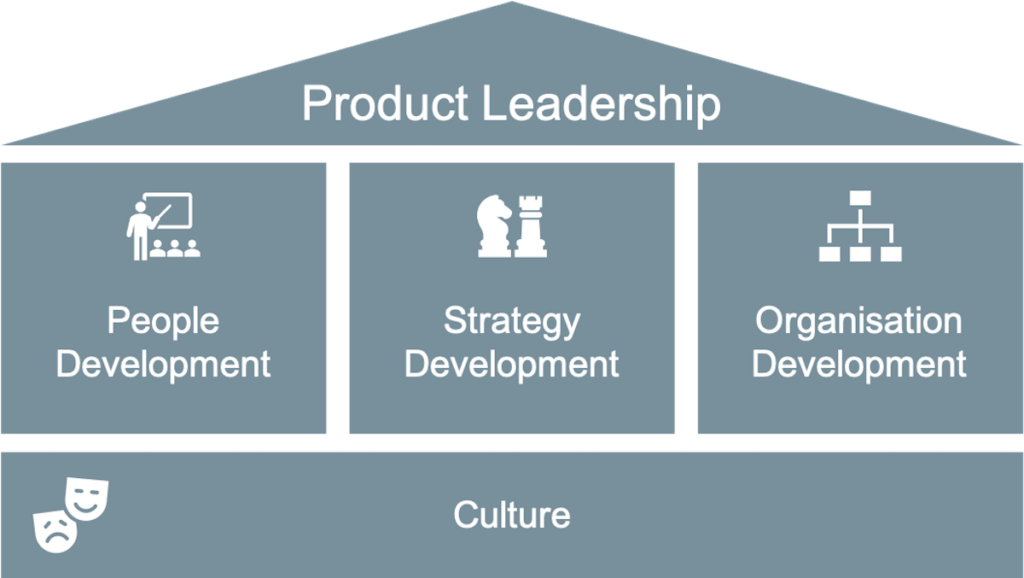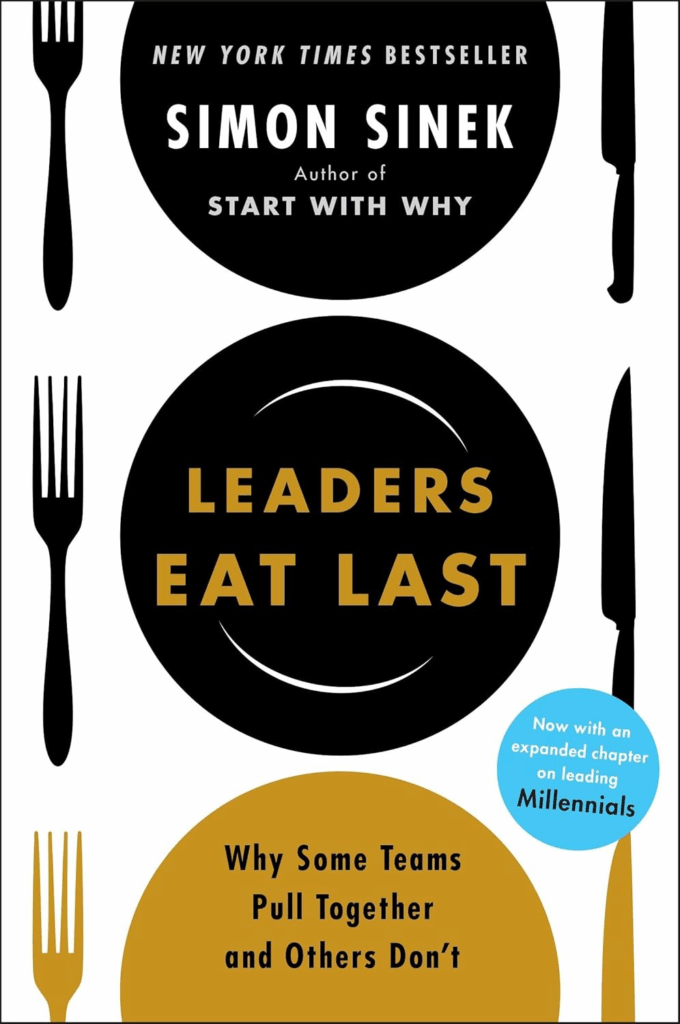Table of Contents
TL;DR – Product Leadership: 4 paths to success
Becoming a Product Leader is not just a promotion – it’s a shift in mindset, responsibility, and influence. Suddenly, it’s no longer just about building great products yourself, but about enabling others to do so at scale. This blog post outlines four key principles that help new and experienced Product Leaders navigate the transition with clarity and confidence:
- Let go of micromanagement: Knowing the product inside out is valuable—but trying to control every detail is counterproductive. Leadership means creating space for your team to grow, not stifling it.
- Step back from hero mode: Good leaders don’t need to have all the answers. Support your team, value their expertise, and build collective ownership rather than spotlighting your own.
- Be open to feedback: Feedback is not a threat—it’s a growth tool. Embrace reflection and vulnerability as strengths, not weaknesses, to foster trust and continuous improvement.
- Lead with empathy and transparency: Strong leadership is built on mutual understanding and clear communication. Align your team around shared goals and make expectations visible and realistic.
In short: Product Leadership is about multiplying impact through people, not controlling outcomes directly. The sooner you embrace this shift, the more successful (and sustainable) your leadership will be.
Product Leadership – What’s it all about?
One of the next potential paths for a Senior Product Manager is a leadership position. This can take the form of a purely functional role (Lead Product Manager) or a disciplinary role (Team Lead or Head of Product). However, many product managers are unaware that their daily work will significantly change with this new role. The new position brings new requirements that require experience and a willingness to adapt.
I personally experienced this transformation process in a painful manner. Due to my strong domain knowledge and extensive network within the company, I was entrusted with a team shortly after starting my career. The outcome? Disastrous. I had underestimated the new role entirely and, lacking leadership experience, I was unable to leverage the crucial levers for my new task.
Looking back, I realise that I displayed similar behavioural patterns back then to those I have observed in some of my own superiors or those in adjacent roles throughout my career.
- Micromanagement: It’s only human to stay in your comfort zone. For product managers, that’s often deep product and domain knowledge. While knowing your area is important as a leader, it’s not your job to meddle in the team’s details. Doing so restricts autonomy, creates frustration, and hinders the team’s growth as a learning organization. Plus, micromanagement doesn’t scale – and is one of the most common causes of leadership burnout.
- Hero syndrome: When leaders misunderstand their role, they tend to put themselves at the center or act as if they have all the answers. But just like micromanagement, that’s neither realistic nor helpful. Coming from a hospitality background, I like to compare this to a restaurant kitchen: if the head chef thinks they’re better than the garde-manger or the saucier, something is seriously off.
- Lack of openness to feedback: Hero syndrome doesn’t mix well with critique. But being receptive to feedback is essential for any Product Leader to grow. Without the confidence to reflect and self-correct, trust and dialogue within the team will suffer. Over time, the team will start to distance itself – because meaningful discussions about strategy or execution become nearly impossible.
How can I deliver the most value as a Product Leader?
If only it were that straightforward to answer. As always, it depends. It depends on the organization, the maturity of the team, and the skills of the Product Leader. Let’s best approach the topic by examining the key pathways or arenas of the Product Leader.

Product leadership – Employee development
The primary and most crucial aspect involves continuously developing the team members. To gain a clear understanding of the tasks and related skills, these must be defined initially. The role of Product Management is intricate, allowing for various interpretations.
I have had positive experiences with the Role Canvas, which defines various roles within a team such as Product Analyst, Product Owner, Lead Product Manager, or Head of Product. This not only sets the stage for personal development but also enhances the understanding of other functions about the role that product management plays in the organisation.
Personal development needs to be ongoing. Managers often limit it to annual feedback sessions. It’s best to categorize activities into short, medium, and long-term horizons. Annually, discuss long-term perspectives with team members. This could involve topics like a functional versus disciplinary career path, transitioning to a different area, or even another role.
At the start of the year, it is best to set out your mid-term goals together. These goals encompass both specific targets, such as achieving certain product KPIs, and personal skill enhancement. As conditions evolve continuously, it is recommended to conduct a progress review every quarter, at the very least bi-annually, to discuss advancements and potentially modify or adjust the goals.
It’s advisable to establish your mid-term objectives early in the year, consisting of specific aims like reaching certain product KPIs and enhancing personal skills. It’s suggested to review progress every quarter, or at least twice a year, to evaluate advancements and possibly update the objectives due to evolving conditions.
Furthermore, I consider the weekly Tête-à-Têtes of 30 to 45 minutes to be valuable. They provide a safe space for discussing not only content-related issues but also help you better assess the mood of team members. Take these appointments seriously, especially in the current situation of distance. Your team will appreciate it.
What are your thoughts on coaching? I am not in favor of the Leader as a Coach strategy. I believe this method is ineffective for various reasons, which will be discussed later. However, integrating specific techniques like Powerful Questions could be useful in Product Leadership.
When it comes to mentoring, there are distinctions to be made. This aspect holds greater significance for a (functional) Lead Product Manager than for a Team Lead. However, a People Manager should also make themselves available as a sparring partner for content-related issues. Regular use of this opportunity also signifies a high level of mutual trust.
Developing strategies for product leadership
I’d like to keep this brief. Not because strategy development is less important, but because I’ve already covered the topic in detail – including: 7 Steps to a Great Product Strategy and Leading by Intent – The Product Owner’s Secret Weapon.

There is a significant distinction between leadership and management – refer to: LEADERSHIP VS. MANAGEMENT: WHAT’S THE DIFFERENCE?. In my role as a Product Leader, I lead, which involves more than just managing people but also guiding the direction of the product. Product Leads often get stuck merely overseeing projects and handling escalations, essentially acting as product managers. A leader is expected to evolve from a manager to a creator.
As outlined in 7 Steps to a Great Product Strategy, it’s vital to note that the Product Leader doesn’t craft the vision, mission, or strategy in isolation. Depending on the circumstances, they consistently collaborate across different levels and functions. The key contributions of Product Leadership involve advocating for the long-term perspective, coordinating strategy development, and effectively communicating the strategy.
Product leadership – Organisational development
Am I a process manager or what? Yes, in a way – But more than that, I am a process, communication, and organizational developer. An essential task of Product Leads is the constant advancement of these areas.
Many times, I hear product teams saying: It’s all good!, No time, we need to focus on the product, not ourselves. or even better: Are there any issues or is anyone complaining?. Just as you continually critique and enhance your product, you must also question and enhance your processes and organisation.
If you’re stepping into a new area as a Product Lead that requires some thematic learning, these are precisely the fields where you can create direct value early on. With a fresh perspective on the organisation and processes, along with suitable experience, you can quickly identify areas for improvement. Another effective approach is to conduct interviews with key stakeholders right at the start to determine where collaboration or working methods need to be enhanced.
Of course, you should avoid being overly impulsive and trying to change everything all at once or question everything right away. This will disrupt the organization and lead to resistance. Instead, focus on one or two issues that you can address consistently with the team. Common issues to consider are:
- Division of work:
Is the product organization structured in a meaningful way? Are teams still “classically” organized around technical artifacts? If so, would aligning them along the Customer Journey be more effective? - Roadmaps:
Are there planning and coordination processes in place at the tactical level? Is there an (agile) roadmap or a portfolio Kanban board that shows key initiatives beyond the current quarter? - Reporting:
Do stakeholders receive regular and appropriately formatted updates on new and planned features? - Dashboards:
Are there dashboards for the most important product KPIs? How are these metrics tracked, discussed, and shared with other departments? - Functions:
Which roles—such as analytics or UX design—are embedded in the product teams? And how well do these functions collaborate with product managers and tech teams?
Leading – Setting an example and cultivating culture
Being a Product Leader comes with a responsibility to set a good example and influence company culture significantly. As a Product Manager, you are already under the spotlight due to the prominent role and numerous interactions with other functions. This aspect gains even more importance for a Leader. So, what does company culture actually mean? Quoting from businessinsider.de:
[…] Just as the cultures of the world symbolize different nations, views, and customs, company cultures represent the community as synonymous with the community functioning within a company.
Gründerszene Lexikon
Gründerszene describes the culture within companies by highlighting values and norms such as fairness, work ethic, trust, openness to criticism, performance orientation, and loyalty, all of which shape the company’s culture. Described as the guiding framework for actions, culture cannot be viewed in isolation but rather defines the how of the first three aspects of Product Leadership.
I can think of additional values and principles in product management that a Product Leader can embed in the organisation in the long term through their behaviour and role modelling:
- Self-reflection – as individuals and as a team
- Openness – to new approaches and experimentation
- Empathy – for customers/users and other roles/ways of working
- Transparency – in planning and goal achievement
- Reliability – in terms of quality and delivery consistency
- …
Product Leadership – Conclusion
Once you are ready to move on from your current tasks as a product manager, new opportunities, pathways, and areas open up for creating added value. While you won’t directly create new products and features yourselves, you will instead provide and evolve the conditions for a successful, robust, and particularly self-organised product organisation.
How do I know if I am successful in my new role? It’s quite simple, and as tough as it may sound – it’s when the structure is so solid and enduring that your team no longer relies on you.
Book recommendation
Click, buy, and enrich me – my literature recommendation on the subject and an enlightening read on leadership: Leaders Eat Last: Why Some Teams Pull Together and Others Don’t

Hero image: a game of pool by Martin Heckmann


Leave a Reply